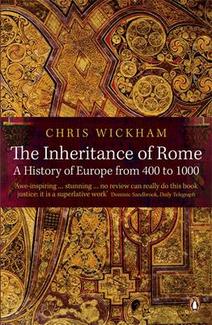
The Inheritance of Rome 400-1000
Chris Wickham
651 pages including index
published in 2009
The way you learn about history as a kid, both in school and through pop culture is as discrete chunks. You got your prehistory, your Bronze Age, your Greeks and Romans, your Biblical Times if you're in an Christian school, your Middle Ages and so on and so weiter. It's comprehensible, makes history all very neat and tidy and of course completely wrong. This is not a new truth of course, but it was driven home for me once again by Chris Wickham in The Inheritance of Rome, which is all about showing the continuity the Early Middle Ages had with the Late Roman Empire, without being blind to the ways in which Europe evolved away from its Roman era roots during this period. There is no bright line you can draw that divides these two eras.
Nor is there a Dark Age. As Wickham puts it in his introduction, the centuries between the Fall of Rome and the Central Middle Ages, between 400 CE and 1000 CE, tend to fit it awkwardly with the traditionally whiggish view of history as one of inevitable progress leading from antiquity to modern times, where Classic Antiquity can be seen as a vanished Golden Age, with the Renaissance or Late Middle Ages as the starting point for that story of inevitable progress, the centuries inbetween banished to the awkward limbo of the Dark Ages. When these centuries were treated in traditional history it was because that's when modern European nations like France or England got their first start. Neither view sits well with Wickham, who argues that these essentially teleogical views of this transitional period, judging them in the context of what came after them, give the wrong image. You have to look at this time on its own terms rather than trying to glean the beginnings of future developments in it.
Wickham therefore tries to write the history of this period on its own terms, rather than as a dull intermission between the glories of the Roman Empire and the excitement of the Renaissance and the development of the modern world. Which means that he doesn't spent much or any time on the old chestnut of who or what was to blame for the fall of the Roman Empire. Instead he starts with an overview of what the Roman world looked like in 400 CE, when it certainly hadn't fallen yet, then details how it broke down -- with the breaking of the tax link between Africa and Rome through the Vandal invasion of Africa being the one event that the western empire couldn't recover from.
Wickham then goes on a socio-economical and political tour of the Post-Roman west, bringing the story up to about 750 CE. He starts with the most coherent of the post-Roman states, Merovingian Gaul and Germany, then moving on to Spain and Italy, where the successor states were less powerful, but still managed to maintain some part of the Roman sociological heritage, albeit on a much smaller scale. Not so much though in Britain, which was the Roman province in which the collapse of the empire hit the hardest. Britain became a "land without kings", much like Ireland also was, which of course had never been part of the empire. Wickham then moves on and in the next three chapters surveys post-Roman cultural attitudes, the role wealth and exchange played in the economies of these states, how this impacted on peasant society as states became richer and aristocracies re-established themselves.
Though The Inheritance of Rome is part of the Penguin History of Europe, Wickham doesn't limit himself to just the west of the Roman Empire as such histories normally do, but in the third part of the book looks at the Eastern successors to Rome: the Byzantine Empire and the successive Arab empires. Both the Byzantines and the Arabs kept much more of the Roman Empire alive than any of the western states could, as they were much richer and suffered much less in the general collapse of the empire. For the Byzantine Empire the greatest challenges came much later than they did in the west, with the seventh century invasions of the Arabs, whom quickly took over its richest provinces and hence forced Byzantium into a radical restructuring.
Wickham ends with a look at the Carolingian and post-Carolingian west. The Carolingian empire was the last long lived empire to unite most of the heartland of the Roman west: France, Germany, Italy and parts of Spain, but in the post-Carolingian world the political space for rulers to operate in became in general much smaller. This was the start of the feudal revolution, which would come to full bloom only after the period Wickham covers. The most important developments in this period, from about 750 CE to 1000 CE, are this fragmentation of political power, no longer dependent on tax but on land and the caging of the peasantry as Wickham puts it, the loss of freedom both economical and otherwise of much of the peasant population of Europe, especially in France. As he argues it, these developments went hand in hand, reinforcing each other.
The Inheritance of Rome was not an easy book to get through, endlessly fascinating but sometimes a bit on the dry side. You need to keep your attention on it to understand what Wickham is saying at all times. Recommended.
Webpage created 15-04-2011, last updated 17-04-2011.